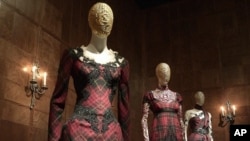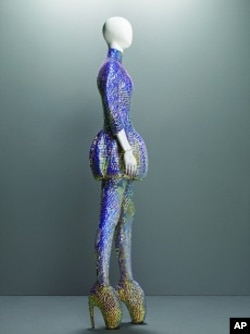A wildly popular show on the late British fashion designer Alexander McQueen is drawing record-breaking crowds to New York’s Metropolitan Museum of Art. The beautiful and outlandish designs in “Savage Beauty,” culled from McQueen’s 20-year career, have the power to startle and enthrall.
There’s an evening gown made of pearly razor-clam shells; a jacket with shoulders topped by alligator heads; shoes that resemble glittering metal hooves; and a headpiece that looks like a cloud of red butterflies. Andrew Bolton, who curated the show, says McQueen was uninterested in the practical aspects of clothing and used fashion to explore new ways of being and feeling.
“I think that McQueen wanted to touch people’s emotions through his fashions. He was almost like a Romantic poet or artist of the 19th century,” Bolton said in an interview. “He saw fashion as something that was a very powerful tool to express identity, but also as a vehicle to discuss rather complex ideas and concepts.”
McQueen found inspiration everywhere: in literature, painting, history, myth and his own life. His Scottish ancestry was a special fascination, highlighted in the 1995 collection titled “Highland Rape.” The garments, some of them torn and slashed, were meant to evoke the violence done to Scotland by Britain in the 1700s and 1800s when thousands of Scots were forced off their lands. In the runway show, according to Bolton’s catalog, the designs were worn by "semi-naked, blood-spattered models that staggered down a runway strewn with heather and bracken. The collection was intended to counter romantic images of Scotland.”
“He was a great provocateur, and he loved provoking reactions from his audience and the press and often colluded in the press in a bad boy reputation,” Bolton says. “So, his early collections are often angry and rather aggressive in terms of styling and presentation.”
Victorian tales of horror were another source of inspiration. A voluminous black cape on a masked mannequin is presented with an eerie wind making the fabric whip about.
“McQueen often explored the darker side of the 19th century, and he loved these contrasting opposites, between lightness and darkness, life and death,” Bolton says. “A lot of McQueen’s characters come from the 19th century Gothic fiction tradition: vampires, highwaymen, femme fatales.”
If McQueen's garments were fanciful, they were also based on the rigorous craftsmanship he learned as an apprentice at men’s tailors on London’s Savile Row. McQueen said he wanted to “empower” women similarly, by giving them clothes that expressed strength - that might even be fearsome. This meant challenging conventional notions of beauty.
“He often said that when he walked around the streets of London, it was ugly things he noticed rather than beautiful things,” Bolton says. “But even in that, he was about reconciling the beautiful and the grotesque. He saw beauty in difference or distinction, not in the classical ideal of beauty, which is about proportion or symmetry.”
McQueen was also fascinated by other cultures, especially China and Japan. Pointing to a gown in the gallery titled “Romantic Exoticism,” Bolton noted that the overdress is made from a Japanese screen that McQueen took apart. It parts in front to reveal an underskirt made of oyster shells.
McQueen constantly turned to nature for inspiration and for materials like shells, tree branches, feathers and horsehair. In contrast, “McQueen’s jewelry was often rather brutalistic in its esthetic,” says Bolton. One neckpiece resembles a cage of thorns.
A Romantic sense of entrapment was a frequent theme in McQueen’s designs. An ivory silk and lace gown from his 2006 “Widows of Culloden” collection is worn with a headdress of resin antlers swathed in a lacy veil that shrouds the face and head. A ghostly hologram of model Kate Moss in an ivory gown that resembles a sea anemone whirling in deep waters is another highlight of that collection and is included in the Met's show.
“Savage Beauty” includes a glass casket holding several pieces from McQueen’s unfinished final collection. He committed suicide in February 2010, a few days after his mother died. He was 40 years old. His former assistant, Sarah Burton, now directs the fashion house that bears his name.
More than 225,000 visitors have flocked to “Alexander McQueen: Savage Beauty,” since it opened in early May. The Museum recently extended the show through August 7 and added Monday hours to accommodate the crowds.



